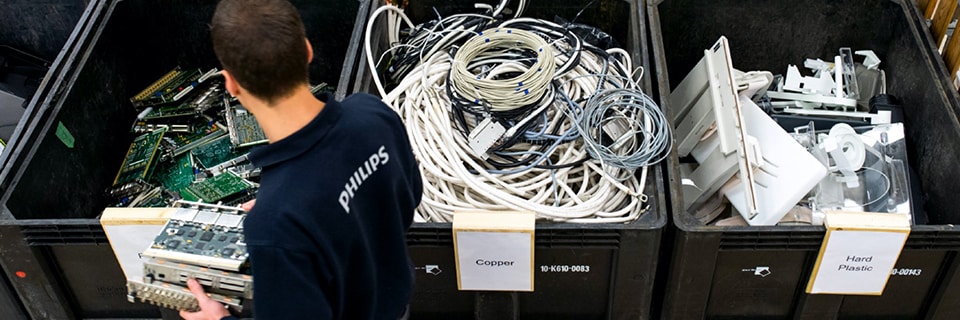Our approach to recycling
Philips supports the principle of Individual Producer Responsibility (IPR) as introduced in article 12.3 of the WEEE Directive. We therefore actively cooperate with our industry partners, the recycling community and other stakeholders to further develop these systems and their supporting financial mechanisms to create the boundary conditions to make IPR work. We see a transition to a Circular Economy as a practical way to implement the Individual Producer Responsibility principle in reality.

Philips supports the setup of recycling infrastructures together with industry partners, where we share a common strategy: creating sustainable financing schemes which guarantee the effective and environmentally sound collection and recycling of WEEE. This approach has proven to be successful in reducing environmental impact, minimizing the costs to society of these activities, raising consumer awareness, and increasing effectiveness of recycling.
Our approach to recycling

Philips supports the principle of Individual Producer Responsibility (IPR) as introduced in article 12.3 of the WEEE Directive. We therefore actively cooperate with our industry partners, the recycling community and other stakeholders to further develop these systems and their supporting financial mechanisms to create the boundary conditions to make IPR work. We see a transition to a Circular Economy as a practical way to implement the Individual Producer Responsibility principle in reality.
Philips supports the setup of recycling infrastructures together with industry partners, where we share a common strategy: creating sustainable financing schemes which guarantee the effective and environmentally sound collection and recycling of WEEE. This approach has proven to be successful in reducing environmental impact, minimizing the costs to society of these activities, raising consumer awareness, and increasing effectiveness of recycling.
Design for recyclability
Recyclability – including designing for disassembly – is critical to reduce the environmental impact of our products at the end of their life and reduce the costs of recycling. Design for recyclability will also allow us to move to the inner loops of circular economy. This is one of the areas we focus on in our EcoDesign approach, as we work to continuously improve the overall environmental performance of our products.
StEP (Solving the E-waste Problem)
Philips is a member of the Solving the E-Waste Problem (STEP) initiative, which is a UN supported global public-private initiative. STEP charter members include Hewlett-Packard, Microsoft, Dell, Ericsson, and Cisco Systems, along with governmental, NGO and academic institutions, as well as recycling and refurbishing companies. The primary goals of this initiative are to standardize recycling processes globally to harvest valuable components in electrical and electronic scrap (e-scrap), extend the life of products and markets for their reuse, and harmonize world legislative and policy approaches to e-scrap. To learn more about STEP please visit http://www.step-initiative.org/
Product recycling services
One way to extend product life and close the material loop is refurbishment. Through its Circular Edition program, Philips refurbishes medical imaging equipment. For products that cannot be repaired or refurbished, recycling can be considered as the next best alternative. For detailed information on how to properly recycle Philips products, please select a recycling service from the list below.
ESG news and insights
You may also find the following articles interesting
You may also find the following articles interesting

